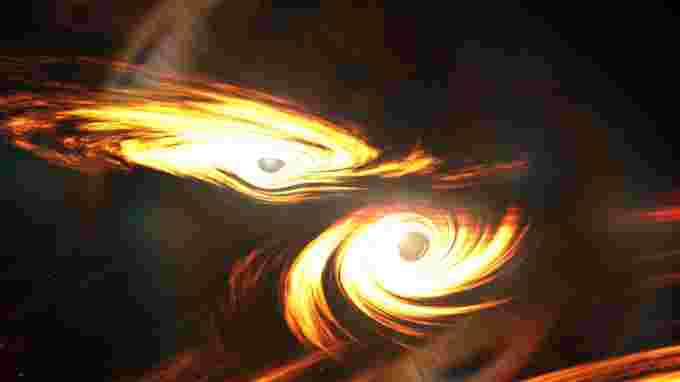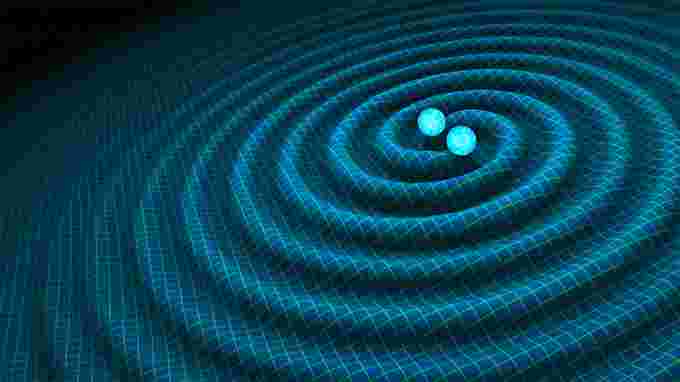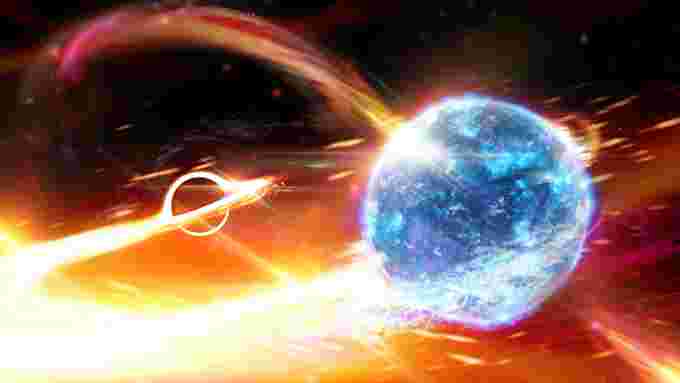Tuesday, June 29th 2021, 3:18 pm – Like ‘Pac-Man’, not ‘Cookie Monster’, astronomers see first confirmed instances of black holes consuming neutron stars.
Astronomers are reporting an exciting discovery from the depths of the cosmos. Tiny ripples in spacetime have been detected, revealing two separate events where a black hole has swallowed up a neutron star.
A little over five years ago, astronomers announced the very first detection of gravitational waves. These ripples in the very fabric of the universe were the result of two black holes — the most extreme objects in the cosmos — spiralling towards each other and merging in a colossal event.
 An artist’s impression of a pair of black holes about to collide to produce an even larger black hole. Credit: Mark Myers, ARC Centre of Excellence for Gravitational Wave Discovery (OzGrav)
An artist’s impression of a pair of black holes about to collide to produce an even larger black hole. Credit: Mark Myers, ARC Centre of Excellence for Gravitational Wave Discovery (OzGrav)
Like the aftermath of tossing a pebble in a pond, the merger of these two objects sent ripples radiating outwards through the universe. These ripples were too small to be felt by anyone. Still, they were seen by LIGO — the Laser Interferometer Gravitational-Wave Observatory — which was specifically designed to detect them.
Since that discovery, more gravitational wave detectors have come online, such as the Virgo detector in Italy and the KAGRA detector in Japan. These have led to the discovery of roughly two dozen confirmed mergers and dozens more candidates. Many of the collisions detected have been between black holes. They have also seen mergers between neutron stars.
 Two neutron stars spiral in towards one another in this artist impression, setting off ripples through spacetime known as gravitational waves. Credit: R. Hurt/Caltech-JPL
Two neutron stars spiral in towards one another in this artist impression, setting off ripples through spacetime known as gravitational waves. Credit: R. Hurt/Caltech-JPL
One type of merger that has eluded them so far is between a black hole and a neutron star. There was a possible detection roughly two years ago. Since then, though, it was ruled as more likely a merger between two black holes of different sizes.
Now, an international team of astronomers has made the first confirmed discovery of a black hole-neutron star merger!
Even more remarkable, after years of trying to find just one such merger, the LIGO and Virgo detectors captured two within just 10 days of each other. The first, named GW200105, was spotted on January 5, 2020, where a black hole about nine times the Sun’s mass devoured a neutron star about 1.9 times the Sun’s mass. The second, named GW200115, was seen on January 15, 2020, involving a six-solar-mass black hole and a 1.5-solar-mass neutron star.
 A dense neutron star spirals in towards the maw of a black hole. Credit: Carl Knox/OzGrav ARC Centre of Excellence
A dense neutron star spirals in towards the maw of a black hole. Credit: Carl Knox/OzGrav ARC Centre of Excellence
The study that details these two discoveries, which involved around 1,400 scientists from across 285 universities and other research organizations, was published in The Astrophysical Journal Letters on June 29, 2021.
“With this new discovery of neutron star-black hole mergers outside our galaxy, we have found the missing type of binary,” Astrid Lamberts, a co-author of the study from Observatoire de la Côte d’Azur, in Nice, France, said in a LIGO press release on Tuesday. “We can finally begin to understand how many of these systems exist, how often they merge, and why we have not yet seen examples in the Milky Way.”
With different detectors in operation in different parts of the world (LIGO Livingston, LIGO Hanford, Virgo, and KAGRA), if they all pick up one of these events, astronomers have a decent chance of locating where it took place in the universe.
For GW200105, though, only LIGO Livingston and Virgo detected it. Furthermore, only LIGO saw a strong signal for it. Thus, while the researchers could narrow down the distance to around 900 million light years away, they couldn’t pinpoint its location. The best they could do was say it occurred in an area of the sky roughly 34,000 times the size of the Moon.
For GW200115, both LIGO detectors and the Virgo detector picked it up. This allowed the astronomers to narrow it down to an area about 3,000 times the size of the Moon and estimate its distance at around 1 billion light years away from us.
LIKE PAC-MAN, NOT COOKIE MONSTER
When black holes collide, nothing escapes to tip us off. We only detect the ripples through spacetime they produce. However, when neutron stars merge, an explosion of energy and light accompanies it, like the ‘kilonova’ explosion that was detected in 2017.
Watch below: ESO Telescopes Observe ‘Kilonova’ from Gravitational Wave Source
